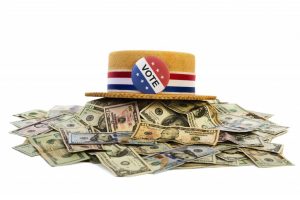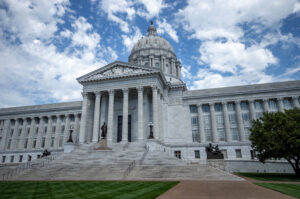8:00
News Story
After four decades, Hancock Amendment continues to shape Missouri tax policy
The amendment’s caps on state revenues, and restrictions on when taxes can be raised, has had long-lasting impacts on Missouri
In the late 1970s, inflation pushed wages into higher tax brackets and squeezed homeowners as property tax bills rose with the value of their residences.
A southwest Missouri businessman named Mel Hancock, inspired by the California tax limitation ballot measure known as Proposition 13, enlisted the Missouri Farm Bureau and put his own plan for controlling taxes on the 1980 ballot.
The “Hancock Amendment” passed with 55% of the vote.
“I am talking about limiting the size of government,” Hancock said at the time. “I am talking about stopping politicians buying votes with tax dollars.”
The Hancock Amendment’s basic control on state government was a limit on how much money could be extracted through taxation. If revenues exceed the limit by more than 1%, the excess has to be refunded.
And from 1995 to 1999, amid unprecedented surpluses, the state sent $971 million in refund checks to individuals and businesses. To stop the annual rebates, in 1997 lawmakers cut taxes on some pensions and removed the general revenue sales tax on food.
But just a few years later, Gov. Bob Holden was asking lawmakers to put a tax increase on the ballot as the state faced a budget shortfall of nearly $1 billion. When lawmakers refused, Holden cut spending, including funds for public schools, to balance the budget.
YOU MAKE OUR WORK POSSIBLE.
Once again, Missouri is enjoying unprecedented surpluses, with about $4.4 billion in the general revenue fund at the end of August. Gov. Mike Parson vetoed a plan for a one-time rebate of $500 million and instead is asking lawmakers to permanently reduce state revenue by $700 million per year.
The General Assembly on Thursday completed work on a tax bill that doesn’t make as large of an immediate cut in income taxes but cuts deeper over time. When fully implemented, it would reduce state revenues by about $1 billion annually.
Democrats with heartburn about Parson’s proposal point to the Hancock Amendment, or more specifically a late-90s tweak made by lawmakers, that would require a statewide vote to undo the tax cuts if the state budget faced a future shortfall.
Meanwhile, Parson is echoing Hancock’s pitch from four decades earlier, saying he wants to limit the political use of tax dollars.
“We’re still gonna have money left over on the bottom line,” Parson said during an August visit to Columbia. “What I don’t want to do is leave a bunch of money on the table and everybody wants to do a pet project and spend money that they won’t be accountable for someday.”
But everything the special session is considering is voluntary. The state isn’t anywhere close to the Hancock Amendment limit and is unlikely to ever get there again.
But exactly why is a little complicated.
The basics
In the fiscal year that ended June 30, 2021, the Hancock Amendment allowed the state to collect for $17.1 billion in what it defines as total state revenue, according to an August report from State Auditor Nicole Galloway.
The actual revenue to the state that counted towards that cap was $13.3 billion.
The cap is determined by applying the ratio of total state revenue when the Hancock Amendment took effect to the personal income of Missourians, as determined by the U.S. Department of Commerce.
That ratio is 5.64% and it allowed for $2.2 billion in revenue in 1980.
Under the amendment, total state revenue is not the same as actual state revenue or general revenue.
Total state revenue does not include money received from the federal government or taxes approved by voters since 1980. It includes, but is not exclusively, general revenue, which can be spent for any state purpose.
The statewide property tax for the blind pension fund is included, as is all but 4 cents of the gas tax dedicated to highways.
GET THE MORNING HEADLINES.
Since the Hancock Amendment was enacted, voters have approved only three statewide tax increases. They enacted a sales tax for schools in 1982, a sales tax for state parks and soil conservation in 1984 and a gas tax increase in 1987.
And on three occasions, in 1992, 1993 and 2021, lawmakers have enacted tax increases that took effect with the governor’s signature. The gas tax was increased twice, in 1992 and 2021, and the income tax was increased in 1993 to support public schools.
One big reason the state is nowhere close to the current limit is that personal income increased 654%, from $39.6 billion in 1979 to $298.6 billion in 2019, while total state revenue only increased 495% in the same period.
Instead of 5.64% of personal income, taxes counted toward the cap take 4.44% of Missourians’ personal income.
Part of the reason taxes lag income growth is a limit on tax legislation added to the Hancock Amendment in 1996.
The annual cap
In 1992, Democratic candidate Mel Carnahan told voters he would ask them to approve a tax increase to support schools if he became governor.
But when a Cole County court ruled that Missouri’s funding mechanism for public schools was inequitable to poorer districts, Carnahan shifted and asked lawmakers to bypass voters. The bill increasing taxes $310 million became law but it generated a backlash.
First came Mel Hancock, by that time in Congress, who got a new version of the Hancock Amendment on the 1994 ballot that would bring all taxes, including those enacted by a vote, under the definition of total state revenue.
Carnahan campaigned hard to defeat it, but after he did so, he turned to Hancock’s partner from the 1980 initiative effort, the Missouri Farm Bureau, to help persuade lawmakers to enact an annual cap on tax increases.
Passed in April 1996 – just in time for Carnahan’s re-election campaign – it allowed for annual new taxes and fees up to $50 million, with a provision adjusting that number for inflation. For fiscal 2021, that cap was $111.8 million.
The annual limit prevents lawmakers from enacting a series of small revenue increases in separate bills. Each year, the estimated net revenue impact is calculated and, if the cap is exceeded, the bills that raise the most new revenue are put to a vote automatically.
By backing the annual limit, Carnahan supported restricting future governors and legislators in ways he and his predecessors had never been limited. Holden, for example, couldn’t just ask for the 1997 tax cut to be reversed without it going to a statewide vote.
The only significant tax hike since the annual cap was enacted is the 2021 increase in the gas tax, 12.5 cents per gallon in all, that is phased in over five years so no single year exceeds the cap.
Absent the annual limit, the full 12.5 cents, raising about $513 million annually for state and local road programs, could have been enacted in one step.
Tax cuts
Another reason total state revenue is unlikely to approach the cap is that lawmakers have chipped away at the state tax base over the past two decades.
Large tax credit programs, like the low-income housing and historic preservation tax credits for developers, and job incentive programs at major employers, prevent revenue from reaching the treasury.
Tax cuts, from the franchise tax – a levy on the value of a corporation – to income tax rates, have further reduced the revenue stream.
The biggest is an income tax cut.
In 2014, over the veto of Gov. Jay Nixon, lawmakers enacted a phased-in tax cut that, with subsequent legislation, has reduced the top income tax rate from 6% to 5.3%. The Senate-passed bill that will be heard in the House Budget Committee would, over time, reduce the top rate to 4.5%.
Each 0.1% in the top tax rate returns $110 to $120 million. That means the 2014 and subsequent tax cuts are worth almost $900 million, or about one-fourth of the gap between the Hancock Amendment limit and actual revenue.
Local governments
The Hancock Amendment doesn’t just limit state tax revenue. It also both limits and protects local governments.
Those provisions include:
- All local taxes must be approved by voters. A new tax or increase must go on a ballot unless the rate has been set below that previously approved by voters.
- The state can’t reduce support for local government functions, like holding state prisoners, or force local governments to take on new duties without providing the funds necessary for the task.
- Property tax rates, a mainstay for financing of school districts and other local jurisdictions, must be adjusted to avoid windfall revenues from rapid increases in values.
The formula for limiting property taxes is not intended to make sure every taxpayer pays the same in taxes as they did the year before. Instead, it is designed to make sure the government spending the tax money has about the same total amount.
The Hancock Amendment directs districts imposing property taxes to calculate how much total assessed value has increased and how much money would be raised by the tax rate used the previous year.
The expected revenue is compared to the money realized the previous year, adjusted for inflation and subtracting taxes from new construction. If the adjusted revenue exceeds the calculated limit, rates must be reduced.
But if assessments on houses in one neighborhood increase 10% while values in another neighborhood go up 20%, the impact of the rate reduction will be uneven.
Hancock, soon after he was elected to Congress in 1988, said he wanted to put something similar in the federal constitution. It never passed.
“I think it has been very beneficial to the state of Missouri,” he said of his amendment.
In his 2011 obituary of Hancock, longtime Missourinet broadcaster Bob Priddy wrote that the verdict is still out on whether it has been good or bad for the state.
“Thirty years after its passage, the Hancock Amendment is still cursed by those who believe it has forever relegated Missouri to a lower tier of states in terms of services to citizens,” Priddy wrote.
“Others are just as passionate in describing Hancock’s amendment as a blessing that forces government to set priorities instead of setting higher tax rates,” he wrote, “and protecting local taxpayers from being forced to pay for local services the state has ordered local governments to provide.”
Our stories may be republished online or in print under Creative Commons license CC BY-NC-ND 4.0. We ask that you edit only for style or to shorten, provide proper attribution and link to our website. AP and Getty images may not be republished. Please see our republishing guidelines for use of any other photos and graphics.





